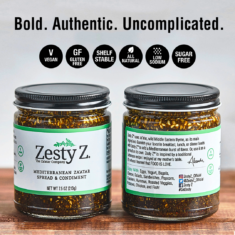From country to country, the specific ingredients that factor into local Zaatar depend largely on what grows nearby, what’s in season, and historical flavor trends that can date back centuries. Unique blends pull from thyme, cumin, marjoram, sumac, and oregano. Zaatar is a spice blend that varies widely throughout the regions that utilize it, and although it’s an ingredient that some have never heard of, it features in most every Middle Eastern kitchen from the Gulf to the Mediterranean.
When they co-founded Zesty Z in 2015, Alexander Harik and his mother, Lorraine Harik, felt that the United States might finally be ready for the Middle Eastern flavors they’ve known and loved all their lives. Harik was ready to leave behind his career in finance to stake his name on Zesty Z, and it didn’t take a lot of convincing to get the rest of his Lebanese relatives on board with the operation. “My whole family is involved,” Harik said. “It’s my mom’s recipe and she’s my co-founder. My dad is heavily involved with operations and working with our suppliers. My sisters are both involved and I have a cousin who works in finance for us.”
Although Zaatar is most commonly found as a dry spice blend, Zesty Z adds extra virgin olive oil to their secret formula of thyme, sumac, oregano, sesame seeds, and salt. This condiment approach is inspired by the Harik family’s Lebanese roots—the Zaatar they’ve always kept on their kitchen tables has been a condiment instead of a dry spice mix. Because Zesty Z Zaatar has a shelf-life of two years, it stays fresh for up to a year once you crack open a fresh jar, even without refrigerating. Harik believes this will encourage American home cooks to use it more often and learn to love the ingredient. “It happens to me all the time, your refrigerator ends up being a condiment graveyard,” said Harik. “Shelf stability and no refrigeration is a game changer.”

Harik notes that he was encouraged to pursue the opportunity because of the popularity of other foods that were successfully adapted from Middle Eastern cuisine. “Every Middle Eastern and Mediterranean kitchen usually has four pantry items: an olive oil, a hummus, a strained yogurt, and a zaatar,” Harik said. Considering three of those products have already found million and billion dollar markets in the United States, Harik didn’t hesitate to bank on the fourth. And even after scaling up for production across 150 stores in nine states alongside e-commerce on their website and through Amazon, Harik estimates that Zesty Z’s signature Zaatar blend is still about 90% authentic to his mom’s heritage recipe. “This is how we grew up, my mom fed us this Zaatar our whole lives.”











